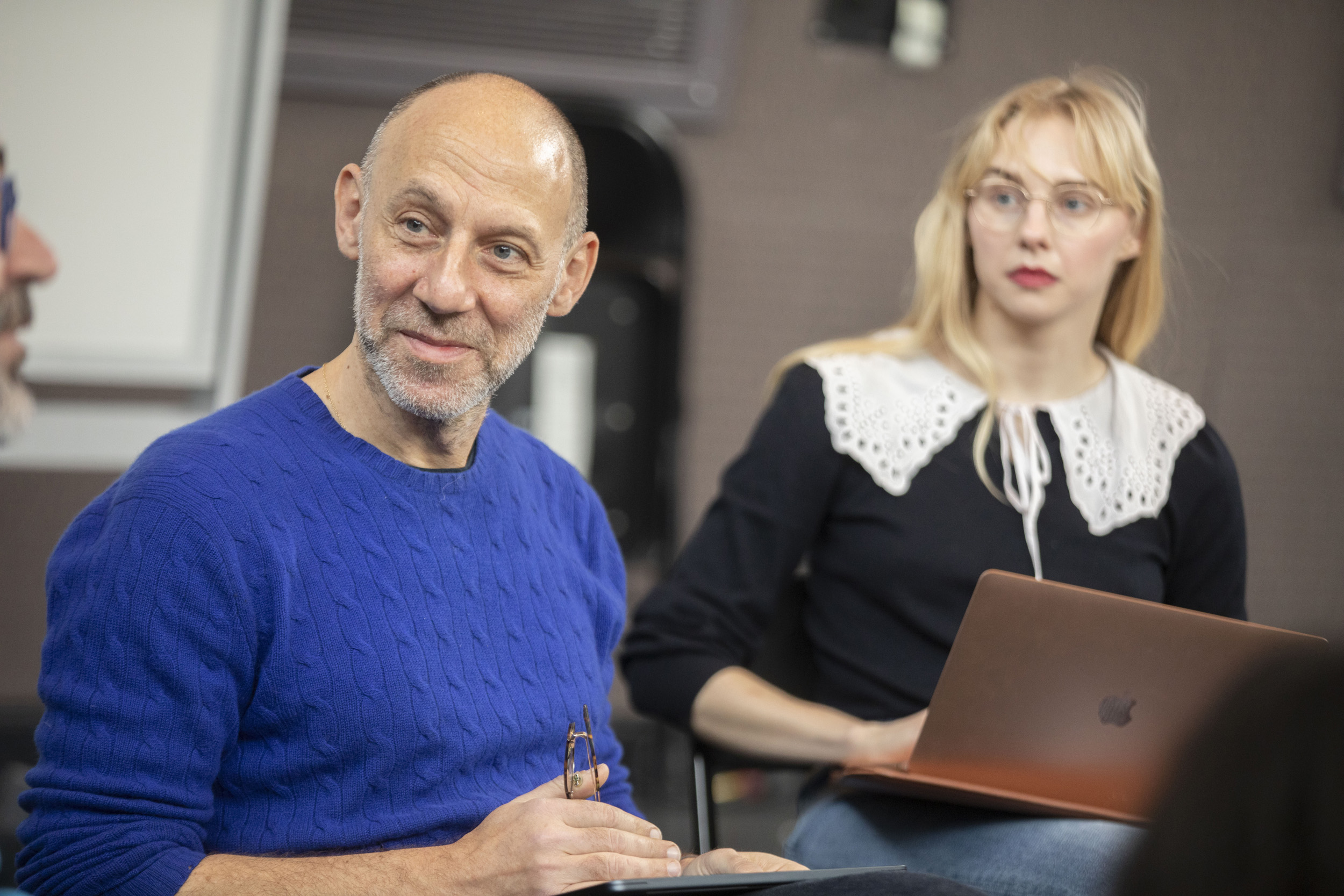
Amelie Jülicher ’25 (left) and Matt Given ’25 take to the stage with their theatrical version of “The Exorcist.”
Photos by Kris Snibbe/Harvard Staff Photographer
Why ‘The Exorcist’ is really more of zombie thing
English course offers kaleidoscopic, cross-disciplinary look at horror classic as film, potential play, cultural artifact with long shadow
The class starts in the dark. One student, swathed in white cloth, reclines against a mirrored wall. She is soon surrounded by a half-circle of peers, while another classmate begins reciting The Lord’s Prayer. Soon after, all hell breaks loose — metaphorically — as the seated student begins writhing and speaking in tongues. The scene, a reinterpretation of one from the 1973 horror film “The Exorcist,” then disbands, and the students regroup, preparing for a seminar-style discussion with a professor from the Divinity School. Another weekly installment of English 90ex, “The Exorcist,” is underway.
New this semester, English 90ex is the brainchild of David Levine, M.A. ’96. The course bridges social commentary, popular culture, psychology, and religion; explores the influence of the 1973 classic; and reflects Levine’s interest in cross-genre studies of theater, performance, video, and photography.
“For the first month, students do presentations on topics that are directly or obliquely related to ‘The Exorcist,’” explained Levine, a professor of the practice of performance in Theater, Dance & Media. Playing on themes raised by the film, which helped make Linda Blair, then 14, a star, those topics have ranged from the performance of dissociative identity disorder to horror and queerness and the Satanic panic of the 1980s. Following these presentations, students apply their newfound knowledge to crafting a theater piece.

Students are asked to grapple throughout with a question that Levine says “looms large” in the course: “Is horror possible in theater? We know we can do it in movies. We know we can do it in novels, but theater’s slightly different.” Indeed, the group performing The Lord’s Prayer scene, “had done a lot of research into haunted houses,” he said. (He found out later they also developed “protocols … in case people started giggling.”)
For Levine’s students, the idea of a performance class that touches on so many subjects is a perfect complement to courses with more straightforward curricula. As an English concentrator with a longstanding extracurricular interest in theater, Matt Given ’25 was intrigued by an “academically rigorous” opportunity to take a performance class that intersected with so many other captivating themes. Among those, he cited “the absolute myriad ways you can talk about religion, horror, children and horror, feminism and horror, theatrics and horror — all these wonderful things that I find myself very interested in.”
“I was intrigued by the idea of a class starting with literary analyses of one film and the book upon which it is based and progressing to creating and performing a new story off the inspired energy of the horror genre,” said Jonathan Weiner ’23. Although the English concentrator described his education as “conventionally academic,” he was “looking for creative outlets in seminars for my remaining English concentration credits.”
For Levine, the movie’s appeal lies partly in its cultural status. “I’m really interested in zombie forms.” Not exactly the undead, he explained, but cultural artifacts that have “an ongoing life even though they’ve outlived their relevance,” he said. “They cast very long shadows over the 20th century.” He attempted a previous class on Arthur Miller’s 1949 play “Death of a Salesman,” which he saw as a “similar kind of artifact.” However, that class failed to generate student interest. Yet it’s clear Levine is no stranger to unorthodox theater: as a 2012–2013 Radcliffe Institute fellow, he developed a project, “Character Analysis,” that combined method acting, performance art, and psychology.
Levine, who was 3 when “The Exorcist” came out, has long been intrigued by the movie and its impact on adults of the era. Once he started tracing the roots of such Gothic horror to Jacobean drama of the late 16th and early 17th centuries, he realized how many facets of Western culture it touched on. “The research I had to do to set the class up was really rewarding,” he said. “And I didn’t even get through half of what I meant to read.”
He was also curious how the movie would be received today. “It’s a tool for me to try to understand this object that I grew up with — by tossing it at a bunch of students and seeing what they make of it,” he said. “In a sense, I’m trying to learn what it is from them.”




